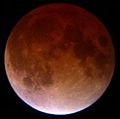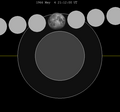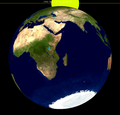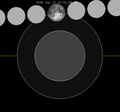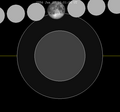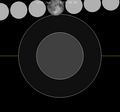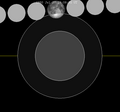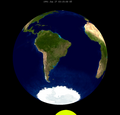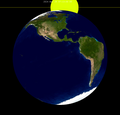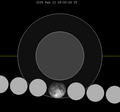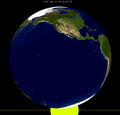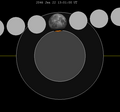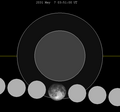May 2002 lunar eclipse
A penumbral lunar eclipse occurred at the Moon’s descending node of orbit on Sunday, May 26, 2002,[1] with an umbral magnitude of −0.2871. A lunar eclipse occurs when the Moon moves into the Earth's shadow, causing the Moon to be darkened. A penumbral lunar eclipse occurs when part or all of the Moon's near side passes into the Earth's penumbra. Unlike a solar eclipse, which can only be viewed from a relatively small area of the world, a lunar eclipse may be viewed from anywhere on the night side of Earth. Occurring about 3.1 days after perigee (on May 23, 2002, at 11:30 UTC), the Moon's apparent diameter was larger.[2] VisibilityThe eclipse was completely visible over Australia, the Pacific Ocean, and Antarctica, seen rising over much of Asia and setting over much of North America and western South America.[3]
In popular cultureThis eclipse appears in the 2022 film Turning Red, although it differs from actual events. It is depicted as taking place on the evening of 25 May, rather than the early morning hours of 26 May. Additionally, the film takes place in Toronto, where the total eclipse was not visible. Eclipse detailsShown below is a table displaying details about this particular lunar eclipse. It describes various parameters pertaining to this eclipse.[4]
Eclipse seasonThis eclipse is part of an eclipse season, a period, roughly every six months, when eclipses occur. Only two (or occasionally three) eclipse seasons occur each year, and each season lasts about 35 days and repeats just short of six months (173 days) later; thus two full eclipse seasons always occur each year. Either two or three eclipses happen each eclipse season. In the sequence below, each eclipse is separated by a fortnight. The first and last eclipse in this sequence is separated by one synodic month.
Related eclipsesEclipses in 2002
Metonic
Tzolkinex
Half-Saros
Tritos
Lunar Saros 111
Inex
Triad
Lunar eclipses of 2002–2005This eclipse is a member of a semester series. An eclipse in a semester series of lunar eclipses repeats approximately every 177 days and 4 hours (a semester) at alternating nodes of the Moon's orbit.[5] The penumbral lunar eclipse on June 24, 2002 occurs in the previous lunar year eclipse set.
Metonic seriesFirst eclipse: May 26, 2002. Second eclipse: 26 May 2021. Third eclipse: 26 May 2040. Fourth eclipse: 27 May 2059. Saros 111This eclipse is a part of Saros series 111, repeating every 18 years, 11 days, and containing 71 events. The series started with a penumbral lunar eclipse on June 10, 830 AD. It contains partial eclipses from September 14, 992 AD through April 8, 1335; total eclipses from April 19, 1353 through August 4, 1533; and a second set of partial eclipses from August 16, 1551 through April 23, 1948. The series ends at member 71 as a penumbral eclipse on July 19, 2092. The longest duration of totality was produced by member 35 at 106 minutes, 14 seconds on June 12, 1443. All eclipses in this series occur at the Moon’s descending node of orbit.[6]
Eclipses are tabulated in three columns; every third eclipse in the same column is one exeligmos apart, so they all cast shadows over approximately the same parts of the Earth.
Tritos seriesThis eclipse is a part of a tritos cycle, repeating at alternating nodes every 135 synodic months (≈ 3986.63 days, or 11 years minus 1 month). Their appearance and longitude are irregular due to a lack of synchronization with the anomalistic month (period of perigee), but groupings of 3 tritos cycles (≈ 33 years minus 3 months) come close (≈ 434.044 anomalistic months), so eclipses are similar in these groupings.
Inex seriesThis eclipse is a part of the long period inex cycle, repeating at alternating nodes, every 358 synodic months (≈ 10,571.95 days, or 29 years minus 20 days). Their appearance and longitude are irregular due to a lack of synchronization with the anomalistic month (period of perigee). However, groupings of 3 inex cycles (≈ 87 years minus 2 months) comes close (≈ 1,151.02 anomalistic months), so eclipses are similar in these groupings.
Half-Saros cycleA lunar eclipse will be preceded and followed by solar eclipses by 9 years and 5.5 days (a half saros).[8] This lunar eclipse is related to two partial solar eclipses of Solar Saros 118.
See alsoReferences
External links
|
|||||||||||||||||||||||||||||||||||||||||||||||||||||||||||||||||||||||||||||||||||||||||||||||||||||||||||||||||||||||||||||||||||||||||||||||||||||||||||||||||||||||||||||||||||||||||||||||||||||||||||||||||||||||||||||||||||||||||||||||||||||||||||||||||||||||||||||||||||||||||||||||||||||||||||||||||||||||||||||||||||||||||||||||||||||||||||||||||||||||||||||||||||||||||||||||||||||||||||||||||||||||||||||||||||||||||||||||||||||||













